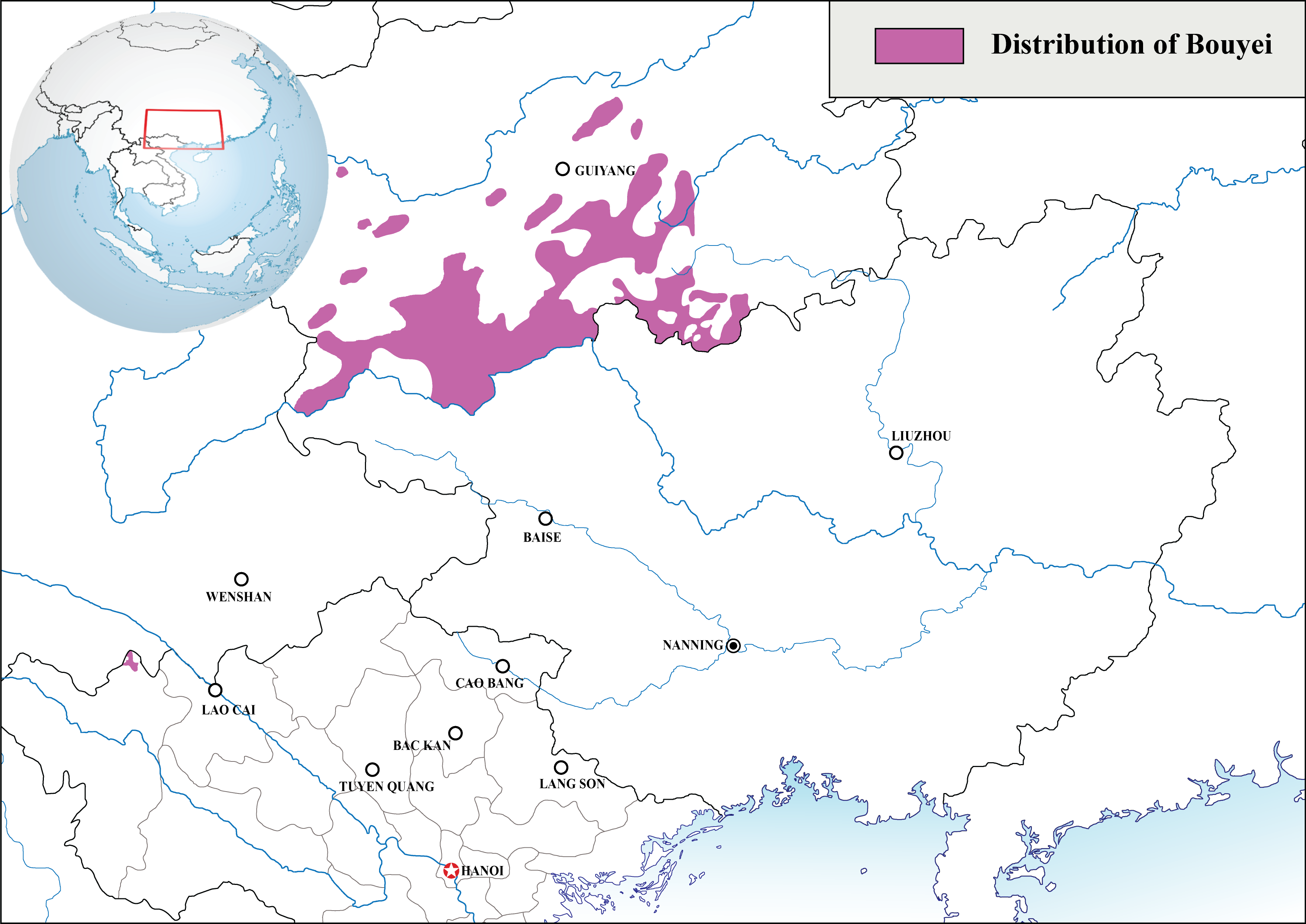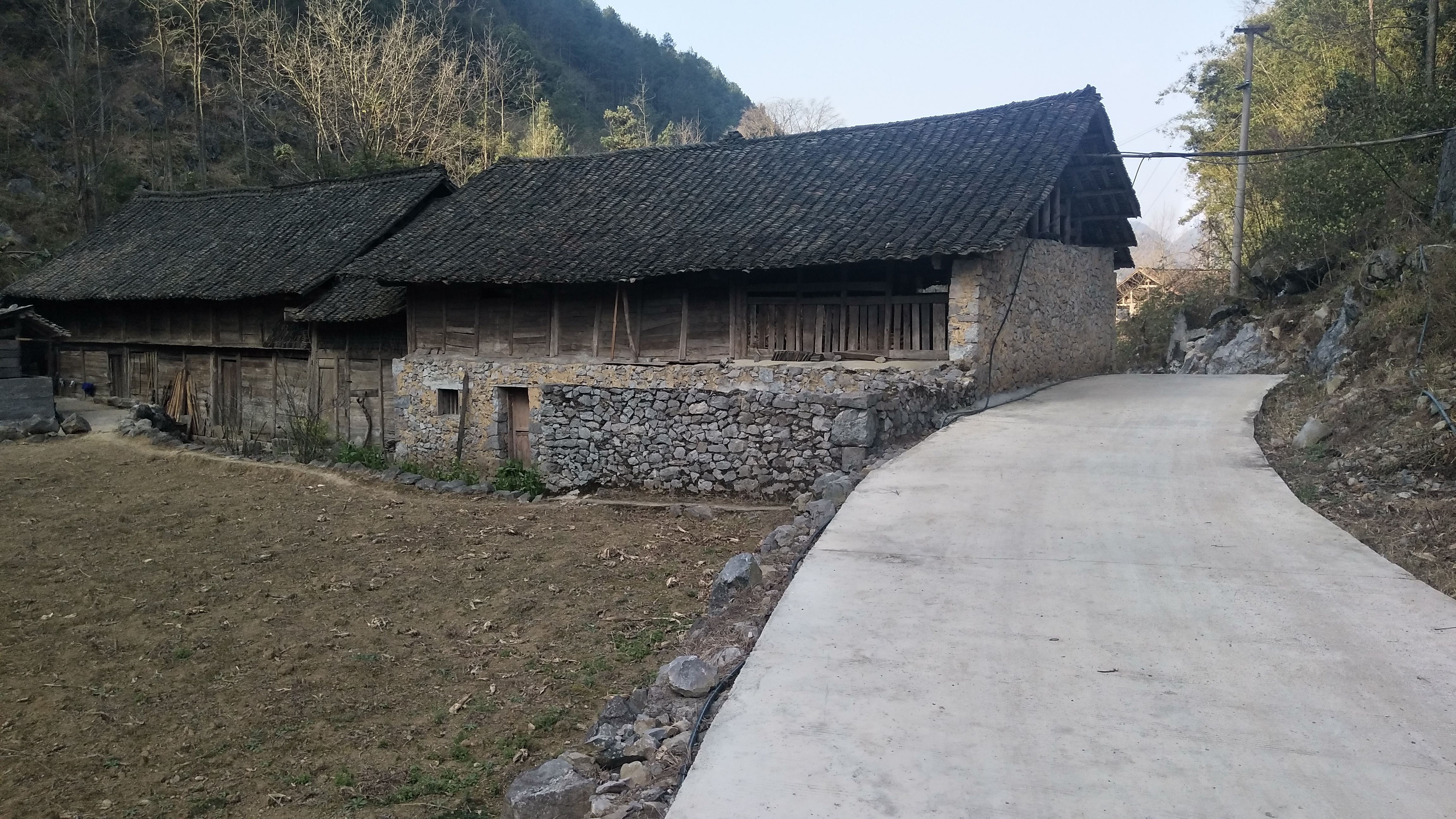|
Buyei People
The Bouyei (also spelled ''Puyi'', ''Buyei'' and ''Buyi''; self called: Buxqyaix, or "Puzhong", "Burao", "Puman"; ; vi, người Bố Y), otherwise known as the Zhongjia, are an ethnic group living in Southern Mainland China. Numbering 2.5 million, they are the 11th largest of the 56 ethnic groups officially recognized by the People's Republic of China. Despite the Chinese considering them a separate group, they consider themselves Zhuang (Tai peoples). The Bouyei mostly live in Qianxinan and Qiannan prefectures of Southern Guizhou Province, as well as in Yunnan and Sichuan Provinces. Some 3,000 Bouyei also live in Northern Vietnam, where they are one of that nation's 54 officially recognized ethnic groups. In Vietnam, they are known as the Bố Y and mostly live in Mường Khương District of Lào Cai and Quản Bạ District of Hà Giang Province. Names The Bouyei consist of various subgroups. Below are their autonyms written in the International Phonetic Alpha ... [...More Info...] [...Related Items...] OR: [Wikipedia] [Google] [Baidu] |
Bouyei Language
The Bouyei language ( autonym: Haausqyaix, also spelled ''Buyi'', ''Buyei'' or ''Puyi''; ; vi, tiếng Bố Y or ) is a language spoken by the Bouyei ethnic group of Southern Guizhou Province, China. Classified as a member of the Northern Tai group in the Tai language branch of the Tai–Kadai language family, the language has over 2.5 million native speakers and is also used by the Giay people ( vi, Giáy) in some parts of Vietnam. There are native speakers living in France or the United States as well, which emigrated from China or Vietnam. About 98% of the native speakers are in China. Bouyei's characteristics are similar to the other members of its language branch. It is generally monosyllabic and word order and particles are the main forms of grammar. Bouyei's syllable initials match up closely to the other Northern Tai languages, with relatively fast simplification and merging. Bouyei sentences can be shown to contain many different levels of phrasing. The contempo ... [...More Info...] [...Related Items...] OR: [Wikipedia] [Google] [Baidu] |
List Of Ethnic Groups In Vietnam
There are 54 ethnic groups in Vietnam recognized by the Vietnamese government.Các dân tộc Việt Nam (Ethnic groups in Vietnam). Portal of the Committee for Ethnic Problems, Hậu Giang prov., 2012. Retrieved 1 Apr 2017. Each ethnicity has their own language, traditions, and subculture. The largest ethnic groups are: Vietnamese 85.32%, Tay 1.92%, Thái 1.89%, Mường 1.51%, [...More Info...] [...Related Items...] OR: [Wikipedia] [Google] [Baidu] |
Ceheng
Ceheng County () is a county in the southwest of Guizhou province, China, bordering Guangxi to the south. It is under the administration of the Qianxinan Buyei and Miao Autonomous Prefecture Qianxinan Buyei and Miao Autonomous Prefecture (; Buyei: ''Qianfxiynanf Buxqyaix Buxyeeuz Ziqziqzouy''; Hmu: ''Qeef Xib Naif Dol Yat Dol Hmub Zid Zid Zeb''), is an autonomous prefecture of Guizhou province, People's Republic of China, bordering G .... Climate References County-level divisions of Guizhou Qianxinan Buyei and Miao Autonomous Prefecture {{Guizhou-geo-stub ... [...More Info...] [...Related Items...] OR: [Wikipedia] [Google] [Baidu] |
Luodian County
Luodian County () is a county under the administration of Qiannan Buyei and Miao Autonomous Prefecture in the south of Guizhou province, China, bordering Guangxi to the south. The climate in the area is humid subtropical, with strong monsoon influences bringing heavy rain during the summer. Winters are dry due to the influence of the Siberian high-pressure system. The county seat and the largest town in the county is also named Luodian; it was formerly known as Longping. The county is frequented by both Chinese and foreign geologists, with the core area of work called Big Guizhoutan, or Big Guizhou Shoal. This has been called a "treasure land for Triassic Period research." Shanghai Daily (English version), August 22, 2005 Hist ...
|
Wangmo
Wangmo () is a Tibetan name. People with this name include: * Dechen Wangmo (Tibetan Buddhist) (died 2011), daughter of a Tibetan noble family *Dechen Wangmo (politician) (born ), Bhutanese politician * Dorji Wangmo (born 1955), Queen Mother of Bhutan * Dorjee Wangmo (born ), Bhutanese politician * Kezang Wangmo, Bhutanese actress, poet, singer and dancer * Kelsang Wangmo (born Kerstin Brummenbaum, ), German Buddhist nun * Kunzang Dekyong Wangmo (1892–1940), Tibetan Buddhist teacher *Mayeum Choying Wangmo Dorji (1897–1994), mother of Queen Grandmother Ashi Kesang Choden of Bhutan * Nilza Wangmo (born ), Indian restaurateur from Ladakh * Tamdrin Wangmo Kelzang Chokyi Nyima (1836–1896), Tibetan Buddhist teacher * Tashi Wangmo (born ), Bhutanese politician * Tsering Wangmo Dhompa (born 1969), Tibetan poet See also * Wangmo County Wangmo County () is a county in the southwest of Guizhou province, China, bordering Guangxi to the southeast. It is under the administration of the Qi ... [...More Info...] [...Related Items...] OR: [Wikipedia] [Google] [Baidu] |
Duyun
Duyun () is the capital of Qiannan Buyei and Miao Autonomous Prefecture in Guizhou province in the People's Republic of China. The area surrounding the city was affected by the Miao rebellion of 1735–36. The city participated in the uprising from the early stages until it was forcefully repressed the following year. History Prior to 1949, Duyun was small, but due to economic development in the surrounding area, it became an economic center. It has expanded along the Jian River, becoming several times its previous size. Administration Duyun City is divided into 5 subdistricts and 4 towns and 1 Ethnic township. Wenfeng subdistrict is the seat of the Duyun City Government and Duyun City Council. *Subdistricts: Wenfeng, Guanghui, Xiaoweizhai, Shabaopu, Lvyinghu *Towns: Mochong, Pinglang, Maojian, Yundong *Ethnic townships: Guilan-shui Climate Education Colleges *Qiannan Normal College For Nationalities () *Qiannan Medical College For Nationalities () *Qiannan Nationality ... [...More Info...] [...Related Items...] OR: [Wikipedia] [Google] [Baidu] |
Dushan County
Dushan County () is a county of 346,000 people (2007) in Guizhou province, China. It is under the administration of Qiannan Buyei and Miao Autonomous Prefecture, in the south of the province, bordering Guangxi to the south. The county seat is the town of Chengguan (). Dushan is located in a mountainous area, with elevations increasing from south to north. The primary river in the county is the Duliu River (), and the annual mean temperature is around and there is total of of rainfall annually. Transportation links include the Guizhou–Guangxi Railway (), the G75 Lanzhou–Haikou Expressway, China National Highways 210 and 312. Important natural attractions are Duxiu Mountain (), Shenxian Cave () and Yuqing Caves (), and Ziquan Lake (). History From 2016 to 2020, the county government spent 40 billion renminbi ($5.7 billion U.S. dollars) on construction projects. Amanda Lee of the ''South China Morning Post'' described these as "white elephant". Guan Video created a 22 mi ... [...More Info...] [...Related Items...] OR: [Wikipedia] [Google] [Baidu] |
2000 Chinese Census
The 2000 Chinese census, officially the Fifth National Population Census of the People's Republic of China (), was conducted by the government of the People's Republic of China with 1 November 2000 as its zero hour. The total population was calculated as 1,295,330,000. The census also covered population growth, number of households, sex, age, ethnicity, educational attainment, and urban and rural population. The census did not include the special administrative regions of Hong Kong and Macau. Population by province-level division Based on the results of the Fifth National Population Census, Henan was the most populous province-level division, Shandong was ranked second, Guangdong and Sichuan were third and fourth, and Jiangsu, Hebei, Hunan, Hubei, Anhui, and Zhejiang were ranked fifth through tenth. Hainan, Ningxia, Qinghai, and Tibet were the four least populous, with fewer than 10 million people each. Tibet was the least populous of all, with 2,620,000 people. There were nine ... [...More Info...] [...Related Items...] OR: [Wikipedia] [Google] [Baidu] |
Congjiang County
Congjiang County () is a county in Qiandongnan Miao and Dong Autonomous Prefecture, Guizhou, China. It is divided by the Duliu River (), the upper reaches of the Liu River, and borders Guangxi to the south. It is an important transit point as the first county inside Guizhou on China National Highway 321 between Sanjiang (Guangxi) and Guiyang, the provincial capital. A large bridge spans the river and connects the city's two halves. Languages In Congjiang County, Miao Miao may refer to: * Miao people, linguistically and culturally related group of people, recognized as such by the government of the People's Republic of China * Miao script or Pollard script, writing system used for Miao languages * Miao (Unicode ... consists of the following three dialects (''Congjiang County Gazetteer'' 1999:129). *''Dialectal area 1'': parts of (); Zhaiping Township () of (); Shangang () and Gaodiao () of Bingmei () *''Dialectal area 2'': Zaibian (), Xishan () (similar to Rongshui Miao ... [...More Info...] [...Related Items...] OR: [Wikipedia] [Google] [Baidu] |
Tone (linguistics)
Tone is the use of pitch in language to distinguish lexical or grammatical meaning – that is, to distinguish or to inflect words. All verbal languages use pitch to express emotional and other paralinguistic information and to convey emphasis, contrast and other such features in what is called intonation, but not all languages use tones to distinguish words or their inflections, analogously to consonants and vowels. Languages that have this feature are called tonal languages; the distinctive tone patterns of such a language are sometimes called tonemes, by analogy with '' phoneme''. Tonal languages are common in East and Southeast Asia, Africa, the Americas and the Pacific. Tonal languages are different from pitch-accent languages in that tonal languages can have each syllable with an independent tone whilst pitch-accent languages may have one syllable in a word or morpheme that is more prominent than the others. Mechanics Most languages use pitch as intonation to co ... [...More Info...] [...Related Items...] OR: [Wikipedia] [Google] [Baidu] |
International Phonetic Alphabet
The International Phonetic Alphabet (IPA) is an alphabetic system of phonetic notation based primarily on the Latin script. It was devised by the International Phonetic Association in the late 19th century as a standardized representation of speech sounds in written form.International Phonetic Association (IPA), ''Handbook''. The IPA is used by lexicographers, foreign language students and teachers, linguists, speech–language pathologists, singers, actors, constructed language creators, and translators. The IPA is designed to represent those qualities of speech that are part of lexical (and, to a limited extent, prosodic) sounds in oral language: phones, phonemes, intonation, and the separation of words and syllables. To represent additional qualities of speech—such as tooth gnashing, lisping, and sounds made with a cleft lip and cleft palate—an extended set of symbols may be used. Segments are transcribed by one or more IPA symbols of two basic types ... [...More Info...] [...Related Items...] OR: [Wikipedia] [Google] [Baidu] |
Hà Giang Province
Hà is a Vietnamese surname. The name is transliterated as He in Chinese and Ha in Korean. Ha is the anglicized variation of the surname Hà. It is also the anglicized variation of Hạ. Notable people with the surname Hà * Hà Kiều Anh, Miss Vietnam in 1992 * Hà Huy Tập, General Secretary of Communist Party of Vietnam The Communist Party of Vietnam (CPV), also known as the Vietnamese Communist Party (VCP), is the founding and sole legal party of the Socialist Republic of Vietnam. Founded in 1930 by Hồ Chí Minh, the CPV became the ruling party of No ... * Hà Văn Lâu, diplomatist * Hà Anh Tuấn, singer * Hà Nguyễn William, Associate professor of endodontics and app developer See also * Kim Hà, main character in Thanhha Lai book Inside Out & Back Again Vietnamese-language surnames {{surname-stub ... [...More Info...] [...Related Items...] OR: [Wikipedia] [Google] [Baidu] |





